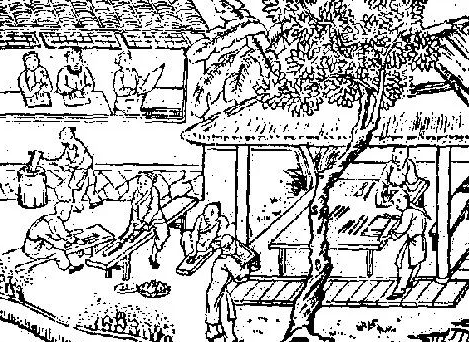The process of invention and development of block printing
In the Five Dynasties, Wuyue with Hangzhou as the center. The economy and culture are flourishing. The rulers, led by King Wu Yue (929-988), were devout Buddhists. Engraved more Buddhist sutras.
In 1917, Tianning Temple Pagoda in Huzhou, Zhejiang Province found a printed Buddhist sutta "Treasure Suitcase Printing Sutta", 7.5cm high, 60cm long, each line of 8-9 words, with an image at the beginning of the image, printed before the image: "King Wu Yue, Marshal of the world printed" Treasure Suitcase printing Sutta "84,000 volumes. Offering in the pagoda. The text such as "Three years of Xiande and three days of age" can be known to have been printed in 956 AD.

In 1924, when the Leifeng Pagoda in Hangzhou collapsed, another Wuyue printed Buddhist sutras called "Baozao Indronyi Sutras" were published in the brick holes of the pagoda, with a frame height of 5.7 cm and a length of 205.8 cm, with 10 to 11 characters per line. The front of the picture was printed with the words "General Marshal of all soldiers and horses in the world, the King of Wuyue made this Sutras 84,000 volumes, enclosing the Xiguan brick Pagoda, making a permanent offering, and the August Diary of Yihai". The year of Yihai was 975. It has been eight years since Song Kaibao, but Song's rule has not yet reached Wu Yue. Lu Xun's article "On the Fall of Leifeng Pagoda" describes this matter. At that time, in order to find the sutra, almost all the bricks of the tower were smashed.
In 1971, another Wu Yue state seal "Treasure Box Indoli Sutra" was found in Shaoxing, Zhejiang Province. It was placed in a 10 cm long bamboo cylinder, and its engraving date was "Yichou" year, that is, 965.
In addition to the above prints found, it is recorded that Yanshou (904-975), a senior monk of Lingyin Temple in Hangzhou at that time, also printed more than ten kinds of Buddhist sutras and Buddha images, totaling 400,000 copies.
The capital of the Southern Tang Dynasty was located in Jiangning (Nanjing). According to the historical records, many books were printed, including the famous Shi Tong by Liu Zhiji (661-221) and the New Ode of Yu Tai compiled by Xu Ling (507-583).
Song, Liao, Western Xia, Jin printing mature period
Following the five dynasties, from 960 to 1279 AD, there were Song, Liao and Jin periods. In addition to the Song, in the north there was Liao established by the Khitan and Jin established by the Jurchen, and in the northwest there was Xixia established by the Dangxiang. In this period. The printing industry has developed by leaps and bounds. Block printing technology has become more mature, and the number of printed books has increased greatly, and the varieties of printed books include Confucianism, Taoism, Buddhism, and various categories such as classics and history subsets. In the history of printing, this period is called the maturity and heyday of printing.
The Song Dynasty opened a brilliant page in the history of printing printing after hundreds of years of development in the Tang and five dynasties, technology has gradually matured, after entering the Song Dynasty, due to the attention and promotion of the government, the printing industry prospered, unveiled the most brilliant page in the history of printing.
The Song version of the book has been passed down to the present few. All generations of book collectors are proud to have Song edition books. Known as "a page of Song edition book, one or two gold" said. Because the Song edition is not only very old. And the collation is fine. Fine engraving, fine paper and ink. This all shows the superb printing skills of the time.
The Song Dynasty ruled the country by literature, and several generations of emperors attached great importance to the construction of culture. Shortly after the founding of the Song Dynasty, they organized and compiled three books, "Taiping Guangji", "Taiping Imperial Review" and "Wenyuan Yinghua"
- EMERSON
- Honeywell
- CTI
- Rolls-Royce
- General Electric
- Woodward
- Yaskawa
- xYCOM
- Motorola
- Siemens
- Rockwell
- ABB
- B&R
- HIMA
- Construction site
- electricity
- Automobile market
- PLC
- DCS
- Motor drivers
- VSD
- Implications
- cement
- CO2
- CEM
- methane
- Artificial intelligence
- Titanic
- Solar energy
- Hydrogen fuel cell
- Hydrogen and fuel cells
- Hydrogen and oxygen fuel cells
- tyre
- Chemical fiber
- dynamo
- corpuscle
- Pulp and paper
- printing
- fossil
- FANUC
- Food and beverage
- Life science
- Sewage treatment
- Personal care
- electricity
- boats
- infrastructure
- Automobile industry
- metallurgy
- Nuclear power generation
- Geothermal power generation
- Water and wastewater
- Infrastructure construction
- Mine hazard
- steel
- papermaking
- Natural gas industry
- Infrastructure construction
- Power and energy
- Rubber and plastic
- Renewable energy
- pharmacy
- mining
- Plastic industry
- Schneider
- Kongsberg
- NI
- Wind energy
- International petroleum
- International new energy network
- gas
- WATLOW
- ProSoft
- SEW
- wind
- ADVANCED
- Reliance
- YOKOGAWA
- TRICONEX
- FOXBORO
- METSO
- MAN
- Advantest
- ADVANCED
- ALSTOM
- Control Wave
- AB
- AMAT
- STUDER
- KONGSBERG
- MOTOROLA
- DANAHER MOTION
- Bently
- Galil
- EATON
- MOLEX
- Triconex
- DEIF
- B&W
- ZYGO
- Aerotech
- DANFOSS
- KOLLMORGEN
- Beijer
- Endress+Hauser
- MOOG
- KB
- Moxa
- Rexroth
- YAMAHA
- Johnson
- Westinghouse
- WAGO
- TOSHIBA
- TEKTRONIX


Email:wang@kongjiangauto.com



































































































































